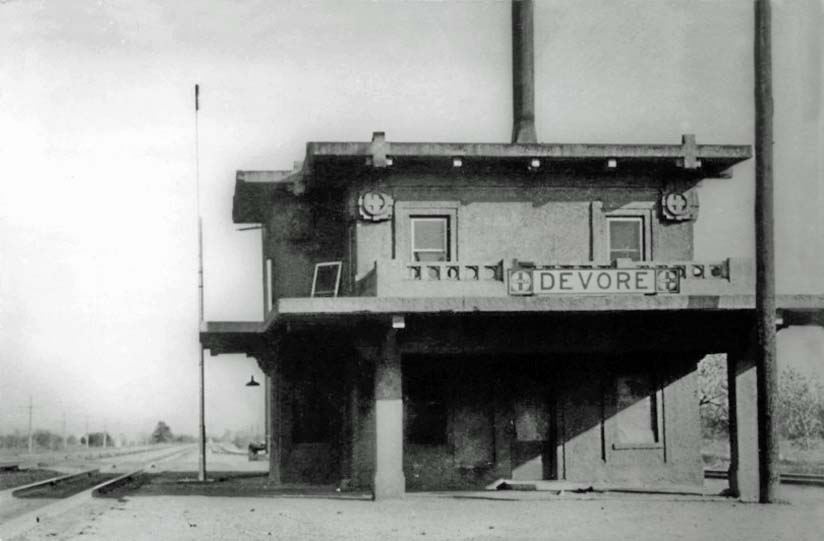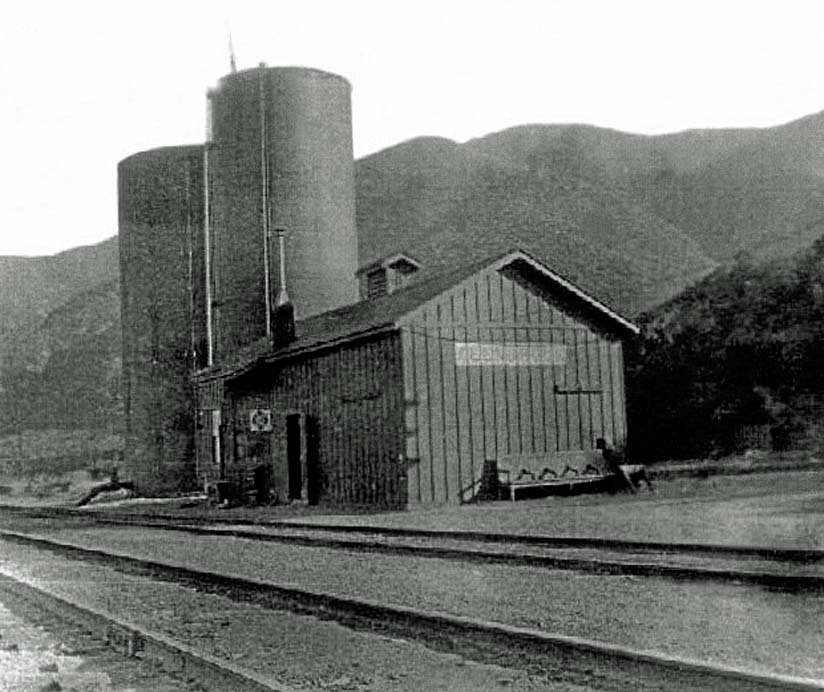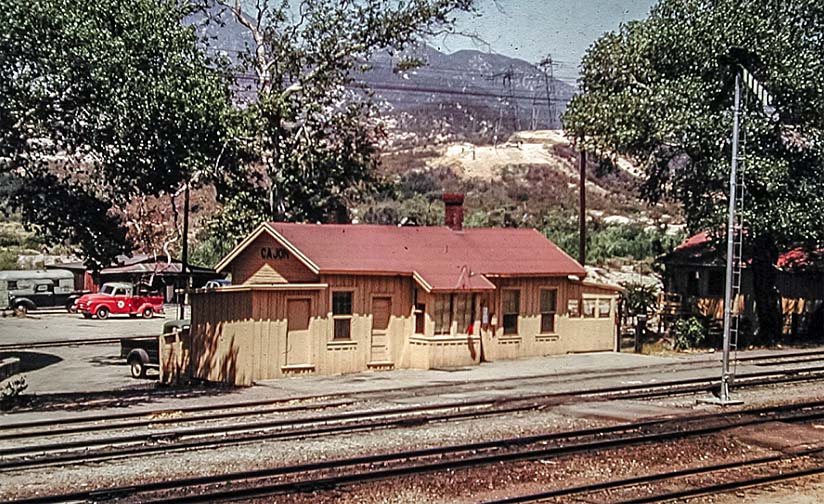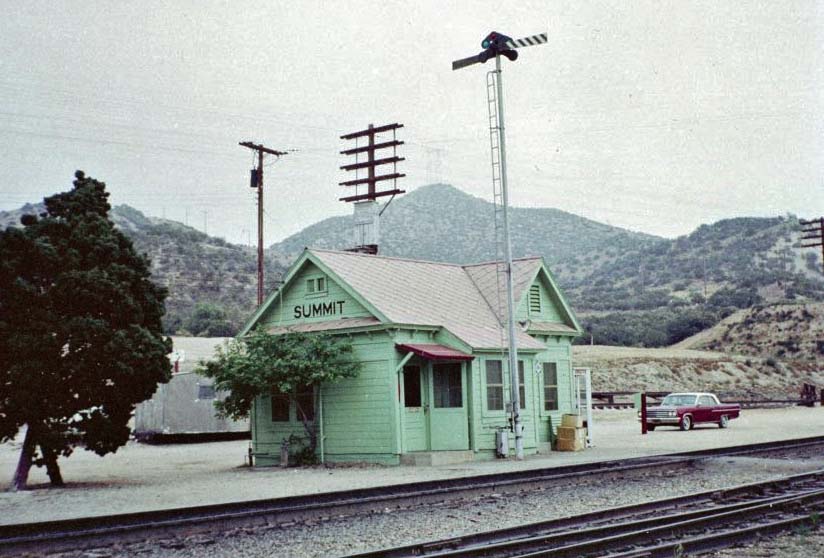
Frustrated motorists inching their way through construction traffic on the 15 Freeway in the Cajon Pass probably have no idea they are just a few hundred feet away from some great historic sites.
Travel through this unique mountain passageway into Southern California began as an Indian footpath, and evolved into wagon roads, a railroad corridor, and eventually the modern highway there today.
In 1885, the California Southern Railroad (a branch of the Santa Fe Railroad) blasted and cut its way through Cajon Pass to construct the first railroad through the rugged mountains, into Southern California.
The railroad built a series of small stations throughout the pass that became tiny outposts of civilization, and a lifeline for local residents.
In the days of steam locomotives, stations were built at strategic intervals along the railroads to provide water and fuel (wood, coal, or oil).
Some stations also served as ticket agencies, freight depots, and housing for railroad employees.
The Devore Station was built in 1904, in the broad, rocky, entrance to Cajon Pass.
The Santa Fe Railroad constructed a substantial two-story concrete depot at Devore to handle passenger and freight service.
This depot was located at the present-day intersection of Glen Helen Parkway and the existing railroad tracks.
Clustered around the depot were a general store, blacksmith shop, school, and several other businesses and homes.
A post office was established inside the depot building in March of 1908.
Local residents and motorists traveling on National Old Trails Highway through Cajon Pass (later designated as Route 66) were pleased when a gas station was opened on Cajon Boulevard at Devore, in 1916.
The ticket agency at the Devore Depot was closed in 1928, but the post office remained open until 1930.
The building was demolished in 1949.
In spite of the depot's closure, the settlement retained its identity, and grew into a well-established rural community.

Keenbrook Station was established by the Santa Fe Railroad in 1891, 4.7 miles up the pass from the future site of Devore.
The site of Keenbrook is located at the end of Keenbrook Road, 1/2 mile west of Cajon Boulevard.
The railroad built a freight and passenger depot, and a water tank at Keenbrook.
The site became known as Keenbrook in 1883, when G.H. Keen purchased the property from James Applewhite.
The Applewhite family owned and operated the Glenn Ranch, located across the ridge, and a few miles west in Lytle Creek Canyon.
Keenbrook became an important location on the Santa Fe line.
Locomotives could take on water there, and passengers could disembark and take a stage over the ridge to the Glenn Ranch, which had become a well-known tourist destination.
A post office was opened briefly in 1894, and then reopened in 1910.
A small school was opened there in 1912, and a few homes dotted the nearby hillside.
Passenger service decreased, and the railroad ticket agency was closed in 1921.
By 1924, the post office and school were shut down.
The railroad used the depot for several more years, but it was retired and removed in 1953.
Today, just a few homes and buildings remain near the tracks to remind us of the tiny railroad community of Keenbrook.

Cajon Station was established in 1885.
This station was located about 600 feet north of the present-day intersection of Cleghorn Road and Cajon Boulevard, just west of the 15 Freeway.
The railroad built a passenger depot at Cajon, and later added a freight house.
This station also had a water tank, and housing for railroad employees.
A post office was established at Cajon in 1889.
With only a few ranches nearby, the area around the Cajon Depot never developed into a community like other nearby stations.
The Cajon post office was closed in 1944, but the station remained active until it was retired in 1961.
The depot was removed in 1962, and only two small concrete slabs remain at the site today.

Summit Station was established in 1885, when the railroad was built through the pass.
The station site is located at the railroad's high point through the pass, near the present-day intersection of Highway 138 and Summit Post Office Road.
If you take Highway 138 four miles east of the 15, you will find a small granite monument on the north side of the road commemorating the depot site.
Summit was a busy station, complete with a passenger depot, freight house, and housing for railroad employees.
A post office was established at Summit in 1898.
The unique mountain scenery and busy rail traffic made Summit a favorite spot for rail fans to watch the trains.
Longtime Santa Fe employee Chard Walker worked and lived at Summit from 1947, until the station was closed in 1967.
He and his wife raised two daughters in the tiny railroad community that had between 20 to 30 residents.
Walker was instrumental in photographing the Cajon Pass and documenting the history of the area.
The local school children attended the Las Flores School in nearby Summit Valley.
The school had a staff of one, Lura Broening, who was principal, administrator, and teacher to grades 1 to 6.
The depot was removed in 1969, but the post office remained open until 1973.
As the roads through the Cajon Pass were improved, automobile traffic increased, and the local passenger traffic on the railroads dwindled.
Ticket agencies were no longer needed, and modern diesel locomotives were able to travel long distances without stopping for fuel, water, or maintenance.
The depots in the Cajon Pass quietly disappeared, as progress made them obsolete.
The tiny settlements that grew up around them either faded away, or blended into the surrounding towns.
Thankfully, the depots were well documented and photographed by rail fans and historians, so the memories of these little trackside communities live on.
Mark Landis.
provisions in Section 29 of the Canadian
Copyright Modernization Act.











